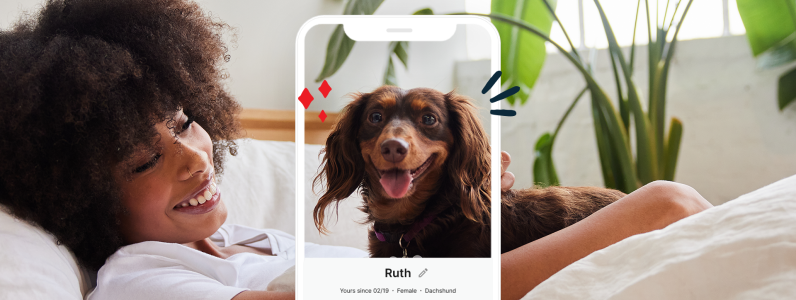If you heard your veterinarian or maybe another pet owner mention it but can’t remember the details, you may be wondering, What is parvo?
Parvo is short for parvovirus. It’s a dangerous disease that is potentially fatal if your dog is unvaccinated. While it most commonly affects puppies, canines of any age may contract parvo.
The good news is parvo infection can be prevented through vaccination. (Remember, in addition to nutritious dog food and exercise, vaccinations can keep your dog healthy.)
Read on to learn more about how the disease is spread and treated, as well as why parvo in puppies is especially dangerous.
What is Parvo in Dogs?
Canine parvovirus is a viral disease that first appeared in the 1970s. It’s transmitted from dog to dog through feces and vomit.
For infected dogs, it begins by attacking the tonsils and lymph nodes. Most of the damage, however, is done to the intestinal lining and bone marrow.
While parvo is highly contagious among certain animals, not every dog exposed to the illness will contract it.
Also, if your pet has parvo and you’re concerned about it spreading to the people in your home, don’t worry – humans can’t catch parvo from dogs. People can develop a different kind of parvovirus known as B19, although it can’t be passed to animals.
Parvo in Puppies
Parvo in puppies is more common than in older dogs, although the disease affects them in the same way – by attacking their gastrointestinal system.
Puppies are most susceptible to parvo between 6-20 weeks of age. During this window of time, your veterinarian will likely administer the parvo vaccine in a series of shots over several weeks. Your puppy may remain vulnerable to the disease, however, until the vaccine schedule is complete.
Where Does Parvo Come From?
Canine parvo is spread between dogs through their feces or vomit, either directly or indirectly.
The virus can live on and spread from objects your dog comes into contact with, such as a leash, bedding, food bowls and other dogs’ hair. It doesn’t have to be visible, either. Microscopic traces of parvo are potent enough to cause infection.
If your older dog is unvaccinated or your puppy hasn’t yet received a parvo vaccine, it’s important to avoid places like dog parks and boarding stations. Socializing with other unvaccinated dogs could be dangerous.
Parvo Symptoms
Whether it’s parvo in puppies or older dogs, the disease has consistent symptoms and can develop quickly. Dogs can start shedding virus as early as four to five days after infection, before signs start to show.
Here are parvo’s common symptoms:
- Bloody diarrhea
- Vomiting
- Fever
- Dehydration
- Lethargy
- Loss of appetite
If you see any of these signs, especially in puppies, contact your veterinarian as soon as possible.
Parvo Vaccine
Remember, parvo can be prevented through an inexpensive vaccine from your veterinarian as part of a schedule of puppy shots.
When puppies are born, they receive antibodies from their mother’s milk that help fight illnesses like parvo (if they’ve been vaccinated against it). Eventually, though, the antibodies lose their power.
While the parvovirus vaccine can be administered as early as six weeks, there is a window of time when the levels of antibodies are too low to provide protection but too high to let a vaccine do its job. Your veterinarian may recommend continuing to give the vaccine at 2- to 4-week intervals until greater than 16 weeks.
That’s why it’s important to keep puppies isolated from unvaccinated dogs while they’re vulnerable to infection.
Note: In areas where the risk of parvovirus is high, vaccinations until puppies are 18-20 weeks old is preferred.
Parvo Treatment
If your veterinarian confirms your dog has parvo, the pet will likely need to be hospitalized. They’ll be given fluids and antibiotics and monitored closely to ensure their condition is improving.
While this level of treatment is the most effective choice, it can also be expensive. If it’s not an option for you, outpatient treatment for parvo may also be available. You’ll need to provide care at home. Talk to your veterinarian about your options.
Fortunately, prognosis for recovery from a parvo infection is good when treated aggressively. For outpatient treatment, the prognosis is fair.
Once your dog recovers from a parvo infection, they’ll have lifelong immunity to the disease.
Disinfecting Your Home After Parvo
Parvo is a hardy disease that can linger on surfaces for months. If your dog is infected, eradicating it from your home takes some effort.
Many household cleaners fail to kill it, so it’s recommended that you treat objects (e.g., food and water bowls) and surfaces with a solution of three quarters of a cup of bleach mixed with one gallon of water.
If your dog plays in the yard, don’t forget to treat this area as well. Instead of bleach, regular watering combined with sunlight can dilute the virus over time.
Remember, if you’re wondering, What is parvo?, and your dog is showing warning signs, contact your veterinarian right away. If they’re healthy but unvaccinated against the disease, your veterinarian can help with that as well.
For more health tips for dogs, learn what our pet experts have to say on our Pet Expertise page.

Your Pet. Our Passion. One App.

Be Rewarded for Your Purina Purchases
Earn and redeem points for Purina products with myPurina app.







